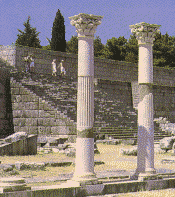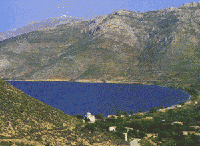Tilos has an area of 63 sq. km. Its terrain is stony, the only exception being a small fertile valley, in the middle of the island. Its permanent inhabitants, most of whom are farmers and stock-breeders, number only 300. Tilos is perhaps the most isolated of the islands of the Dodecanese, after Kastelrizo.  This makes it ideal for holidays of peace and quiet.
This makes it ideal for holidays of peace and quiet.
Furthermore Tilos has many sightseeing such as : The Castle of the Knights stands in Megalo Horio, the island's capital. It is a Byzantine castle which was restored by the Knights of the Order of St John during the Frankish rule. In its interior, are ruins of the acropolis and two sanctuaries of Pythian Apollo and Polian Athena. Today, there stands the church of Archangel Michael. The area of the Castle was the site of the island's first capital until the first post Christian centuries.
From the Castle, the view out over the sea is breathtaking, especially at sunset. The church of the Taxiarch, or the Archangel Michael, stands in Megalo Horio, the island's capital. It is a transport of the church of the same name which was built in the area of the castle on the site of an ancient temple. Inside, there are notable silver icons, a carved wooden screen, a throne, and a 19th century pulpit.
The monastery of Tilos's patron saint, Agios Pandeleimon, is situated in the southeastern section of the island. It is built as a rock, in an area full of running waters, plane trees and cypress trees.  The Monastery is surrounded by a pebble yard (1843) where the huge cypress tree is said to have been standing ever since 1800. The Monastery was built in 1470-80 and includes cells, a guest-house, storage-rooms and a tower. It is said that the Monastery is built upon the ruins of the ancient temple of Neptune. The building took its current form after two renovations, in 1703 and 1824. The remarkable icon stand inside the church was created in the 18th century.
The Monastery is surrounded by a pebble yard (1843) where the huge cypress tree is said to have been standing ever since 1800. The Monastery was built in 1470-80 and includes cells, a guest-house, storage-rooms and a tower. It is said that the Monastery is built upon the ruins of the ancient temple of Neptune. The building took its current form after two renovations, in 1703 and 1824. The remarkable icon stand inside the church was created in the 18th century.
The Monastery of "Panagia Politissa" (Our Lady from Constantinople) stands near Livadia and Mikro Horio on the site where there is said to have been a 3d century BC cemetery. It took its name from the place of birth of the proprietress of the construction it is in. It was built in 1879, and it owes its present form to its redecoration in 1937.The cave of Hardakio or Arkadi, stands near Megalo Horio. It is known for the important palaeontological findings Nikolaos Symeonidis and Georgios Theodorou discovered there in 1971.
There are tools and deer and elephant bones dating from 8,000-7,000 BC. Most of them are exhibited in the Palaeontological Museum of the University of Athens. A small part is on display in the small Palaeontological Collection of Megalo Horio.Tilos can be reached by ferry from Piraeus, Rafina, the Cyclades, Crete, Rhodes and the other islands of the Dodecanese. You can also go by air as far as Rhodes and continue your journey by boat to Tilos.

